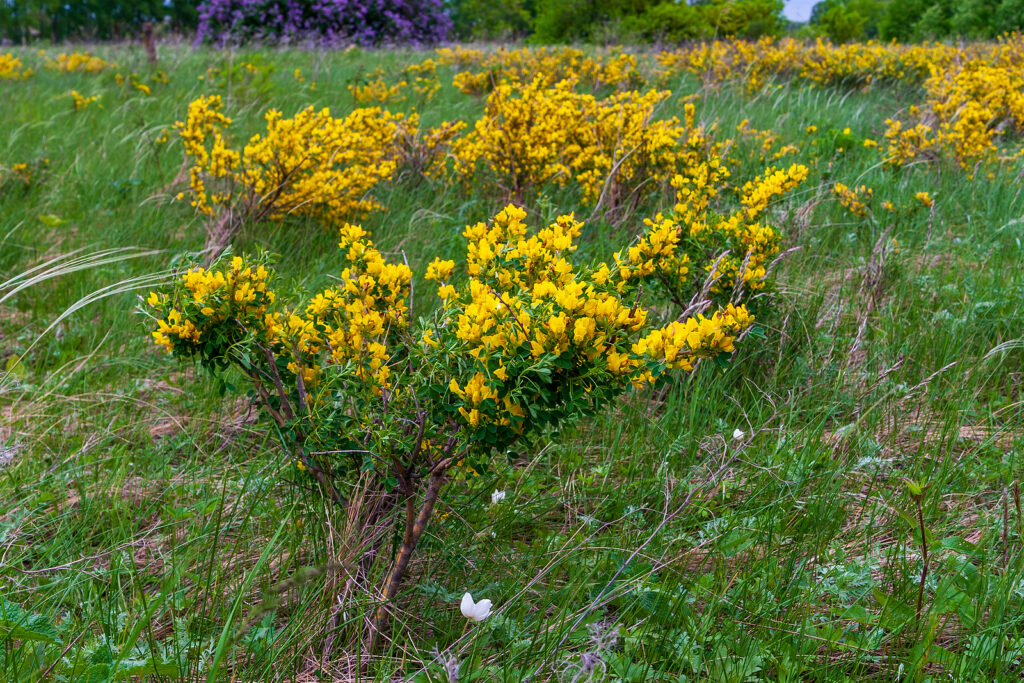Caragana — Peashrub–is grown for its bright green leaves and peas-like usually yellow but sometimes white or pink flowers. The flowers are followed by slender brown pods in autumn.
Caragana is a good choice for shrub borders and windbreaks. It tolerates cold, heat, wind, bright sun and is nearly indestructible in most situations. It grows best in humus-rich, well-drained soils but can thrive in poor, dry soils.
Caragana is a genus of 80 species of deciduous, often spiny shrubs or small trees native dry soils in exposed sites in Eastern Europe and China.

Get to know Caragana
- Plant type: Deciduous shrubs or small trees
- Growing zones and range: Zones 2 to 8 depending on the variety
- Hardiness: Hardy to Zone 2
- Height and width: 5 to 20 feet (1.5-4.6m) with a 6 to 12 foot (1.8-6.1m) spread
- Growth rate: Medium
- Form and habit: Upright and upright
- Foliage: Dense growth of stiff branches; bright green 1.5-3 inch (3.8-7.6cm) leaves that are divided into 8 to 12 leaflets that resemble feathers; the young twigs are yellow-green
- Flowers: Small clusters of fragrant, .8 inch (2cm) yellow pea-shaped flowers line the branches, to be followed in summer by small and slender pods
- Fruits: Slender brown pods to 2 inches (5cm) long in autumn
- Bloom time: Late spring
- Uses: Hedges, cover for wildlife, and serves as an excellent windbreak; useful where choice is limited by cold, heat, wind, and bright sun
- Common name: Peashrub, Siberian pea tree
- Botanical name: Caragana
- Family name: Fabaceae
- Origin: Northern Asia
Where to plant Caragana
- Plant Caragana in full sun.
- Plant Caragana in almost any well-drained soil, but it does best in sandy soil.

When to plant Caragana
- Set container-grown Caragana in the garden in spring or autumn.
- Sow seeds in spring or autumn.
Planting and spacing Caragana
- For a Caragana hedge, plant 2- and 3-foot plants about 1.5-2 feet (.3-.6m) apart.
How to water and feed Caragana
- Give Caragana moderate to little water.
- Feed Caragana with an all-purpose organic fertilizer in spring.
How to care for Caragana
- Prune Caragana’s previous season growth back about one third immediately after flowering.
- To produce dense growth, cut Caragana all the way down to the ground in early spring.
Caragana pests and diseases
- Caragana is infrequently bothered by pests or diseases.

Caragana propagation
- Propagate Caragana from softwood cuttings of young growth taken in late spring or early summer, from semihard cuttings of more mature growth taken in mid- or late summer, or from hardwood cuttings of dormant leafless growth taken in late fall or winter.
- New Caragana plants can also be propagated from root cuttings.
- Sow seeds in container when they are ripe in autumn or in spring.
Caragana varieties to grow
- Caragana arborescens, Siberian peashrub, fast-growing to 20 feet (6.1m), with 15 feet (4.6m) spread. Leaves to 3 inches (7.6cm) long, each with four to six pairs of leaflets.
- C. arborescens lorbergii, Lorberg’s pea tree, has threadlike leaflets that give it a misty appearance. Its flowers are larger than but not as abundant as those of the ordinary species.
- C. frutex, Russian peashrub, to 10 feet (3.1m); leaves have one or two pairs of 1 inch (2.5cm) leaflets.



